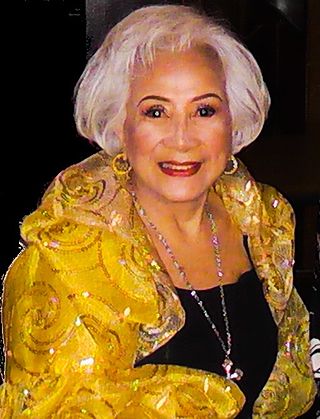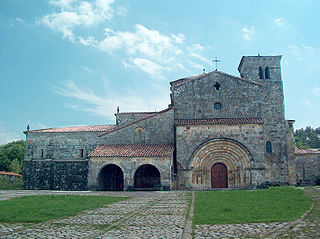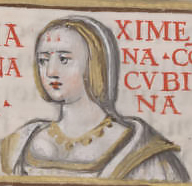
Rodrigo Díaz de Vivar was a Castilian knight and ruler in medieval Spain. Fighting both with Christian and Muslim armies during his lifetime, he earned the Arabic honorific as-Sayyid, which would evolve into El Çid, and the Spanish honorific El Campeador. He was born in Vivar, a village near the city of Burgos.

María Díaz de Padilla was the mistress of King Peter of Castile, whom he posthumously recognised as his wife.

Gumaca, officially the Municipality of Gumaca, is a municipality in the province of Quezon, Philippines. According to the 2020 census, it has a population of 71,942 people.

Ibong Adarna, also known as The Adarna Bird, is an early 19th century Filipino epic poem that centers around a magical bird of the same name. During the Spanish era, the longer form of the story's title was Korrido at Buhay na Pinagdaanan ng Tatlong Prinsipeng Magkakapatid na anak ni Haring Fernando at ni Reyna Valeriana sa Kahariang Berbanya'. Some researchers suggest that the tale may have been influenced by similar European stories.

LVN Pictures, Inc. was a Filipino film studio that was considered one of the biggest in the history of Philippine cinema and its foremost establishment in motion picture post-production until 2005. In its heyday of motion picture production, LVN Pictures has been compared to that of the Metro-Goldwyn-Mayer Studios (MGM) of Hollywood because it had, under contract, the biggest stars and film craftsmen of the period. Before its closure in 2005, LVN Pictures was known as one of the oldest living film studios in the country.
Bayani Casimiro Sr. was a Filipino dancer who was among the leading stars of bodabil (vaudeville) in the 1930s and 1940s. He also appeared in musical films and later in life, in comedic roles. A tap dancer, he was frequently called the "Fred Astaire of the Philippines".
Gines Francisco Soriano, known professionally as Nestor de Villa, was a Filipino actor frequently cast in musical films. He was a gifted dancer, often paired with frequent on-screen partner Nida Blanca in both film and television. His dancing talent led some people to call him the "Fred Astaire of the Philippines", though the same moniker had also been given to Bayani Casimiro.

Clarita Villarba Rivera, better known by her screen name Mila del Sol, was a Filipina actress, entrepreneur and philanthropist. Born in Tondo, Manila, she gained fame in her very first lead role in the 1939 film Giliw Ko. She was discovered by LVN Pictures President Doña Sisang de Leon, who insisted in casting her over the objections of the film's director, who felt she was too young for the part. It was the film's director, Carlos Vander Tolosa, who gave her the screen name Mila del Sol for "causing the sun (sol) to appear as if by miracle (milagro) over his otherwise overcast set whenever she was called in to do her scenes."

Dorothy Guinto Jones, known professionally as Nida Blanca, was a Filipino actress and comedian. In a career spanning five decades, she is known for her dramatic and comedic roles in film and television in the Philippines. After signing with LVN Pictures, she starred in films during the 1950s; in most of the films, she co-starred alongside Nestor de Villa. She gained further prominence in the television sitcom John en Marsha (1973–1990). Blanca was found dead at the Atlanta Centre in San Juan City on November 7, 2001.

El Cid: The Legend is a 2003 Spanish animated film written and directed by José Pozo. It is based on the story of the 11th-century Castilian knight and warlord Rodrigo Díaz de Vivar, better known as El Cid.

Narcisa Buencamino-De León was a Filipino film producer and businesswoman.

Fernando Díaz was a Spanish nobleman and military leader in the Kingdom of León, the most powerful Asturian magnate of the period. He held the highest rank in the kingdom, that of count, from at least 24 September 1089. He was the last Count of Asturias de Oviedo and was succeeded by a castellan, a novus homo, perhaps in an ecclesiastical–royal effort to curtail the power of the Asturian aristocracy.

Agoncillo is a town and municipality in La Rioja province in northern Spain.

Juan Pedro Aladro y Kastriota (1845–1914), known as Aladro Kastrioti by Albanians, born Juan de Aladro de Perez y Valasco, was a Spanish nobleman, diplomat, and pretender of the throne of Albania. He claimed descent from the Kastrioti family through his paternal grandmother, a noblewoman that lived during the era of Charles III. He was referred as Don Aladro.

Child of Sorrow is a 1956 Philippine crime drama-tragedy film directed by Lamberto V. Avellana from a story and screenplay written by Rolf Bayer, with Estrella Alfon and T. D. Agcaoili as story consultants. Set in the slums of Manila, recovering from the aftermath of the Second World War, the story follows Cita, a prostitute with good intentions and Vic, a war hero who served in the Korean War under PEFTOK, living together in the ravaged capital but when they were involved with Cardo's nasty plans, they, along with Father Fidel, join forces to stop him to succeed.

Rodrigo Manrique de Lara was a rebellious Spanish noble who gained notoriety for his prowess in the Reconquista battles against the Muslim invaders. He sided with the Infantes of Aragon during their war against John II of Castile and Álvaro de Luna. He held the title of the first Count of Paredes de Nava and was the Grand Master of the Order of Santiago for the Kingdom of Castile.

Rodrigo Gutiérrez Girón was a magnate and ricohombre from Palencia who played a key role in the Medieval history of the Iberian Peninsula. He was the first one of his lineage to add Girón to his patronymic. Owner of vast holdings and estates, Rodrigo and his relatives formed one of the most powerful clans in Tierra de Campos since the time of the Banu Gómez.

Jimena Muñoz or Muñiz was a noblewoman from the El Bierzo region of the medieval Kingdom of León, and the mistress of king Alfonso VI of León and Castile during the late 1070s and early 1080s. By him she was mother of two countesses and grandmother of Afonso I, first king of Portugal.
Luzviminda Fernandez, better known professionally as Luz Fernandez, was a Filipino actress and television presenter. She was a long-time radio actress for DZRH who also did acting for film, television, and theater.

















